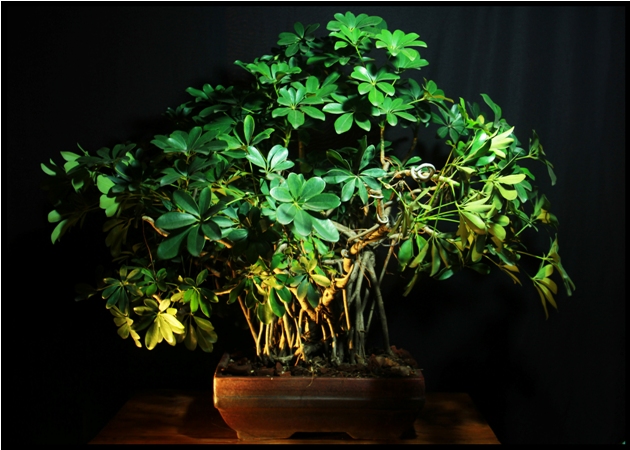POTTIING/REPOTTING
(Excerpt from my essay ” THE LIVING ART OF BONSAI”
At one stage or the other, every bonsai which has been in the same pot for a long time will be required to be repotted just as any potential bonsai will be required to be potted into a shallow, flat ceramic bonsai container for aesthetic purpose. Flat containers represent earth and are therefore desirable if a plant is to look like a bonsai tree. The pot for bonsai is like a frame to a picture. The pot should complement the tree and not detract from its looks. It should therefore not be too ornate or shiny. It should also be in proportion to the bonsai – not too big otherwise the tree will look comparatively smaller and will not give the impression of a big tree no matter how good it is, nor should it be so small that it will look visually unbalanced when compared to the bonsai.
The process of potting is as follows:
a) A suitable bonsai pot is chosen for the tree which is to be potted. The pot should neither be too big nor too small but should be big enough to accommodate the root ball and look appropriately balanced considering the future growth of the tree.
b) The pot is prepared by fixing pieces of netting on the drainage holes with the help of wire. If the tree is to be transported to another place after potting or if it is very tall or heavy and is liable to be shaken by strong winds or if it is feared that the rootage is inadequate, the tree will need to be tied into the pot. For this, insert a length of aluminum wire through the drainage holes so that the ends of the wire stick out of the pot from above. A small quantity of bonsai soil is poured on to the base of the pot and mounded where the tree is likely to be placed.
c) The tree which is to be transplanted in the bonsai pot is first wired if necessary. It is then taken out of the nursery pot in which it is and the soil from the periphery of the root ball is loosened bit by bit. Tangled roots, heavy roots and dead or rotted roots are trimmed off leaving a healthy, fleshy and compact root ball intact. Depending on the species, not more than about one-third to one half of the roots are trimmed off. The base of the root ball is also reduced, if necessary and the root ball is tried for fit in the pre-chosen bonsai pot.
d) Set the root pruned tree in the pot spreading the roots over the mound of soil and rock the tree gently so that the tree settles comfortably. Put Cover the roots with more soil and using a blunt instrument like a chopstick or dibber, poke the soil working it gently into the nooks and crannies between the roots but not in the compact root ball. Stop poking when the tree stops rocking if gently pushed and it appears to be stable. Pour more soil so as to cover any hanging roots and tamp the sides of the pot with the hand to settle the soil. The soil level near the edges of the container should be slightly below the rim of the pot.
e) Set the pot in a basin full of water which reaches just below the rim of the pot. Water will rise by capillary action and moisten the soil. Also spray the foliage of the tree with clean water to wash off any dust and also to provide it with extra humidity.
f) Remove the pot from the basin of water after about 15 minutes and set it in a shady place where it will get partial sunlight, away from winds and direct sun. Gradually, after about a fortnight when new growth is evident, expose the tree to more sunlight in increasing stages.
g) The success of the survival of the newly potted bonsai is in not watering it after the first watering till the soil is just dryish damp. Instead spray the foliage at frequent intervals to conserve moisture. A good alternative would be to provide the tree with a misty micro-climate in a green house or under a closed plastic covering with just enough ventilation to prevent saturation.
Repotting is similar to potting except that in repotting a tree is transplanted from a smaller bonsai pot to a larger pot or sometimes into the same or similar sized pot.
(Tip: Conifers are difficult to transplant in the tropical climates so it is better not to disturb their root balls at all and transplant them in a cooler season or in the rains).


